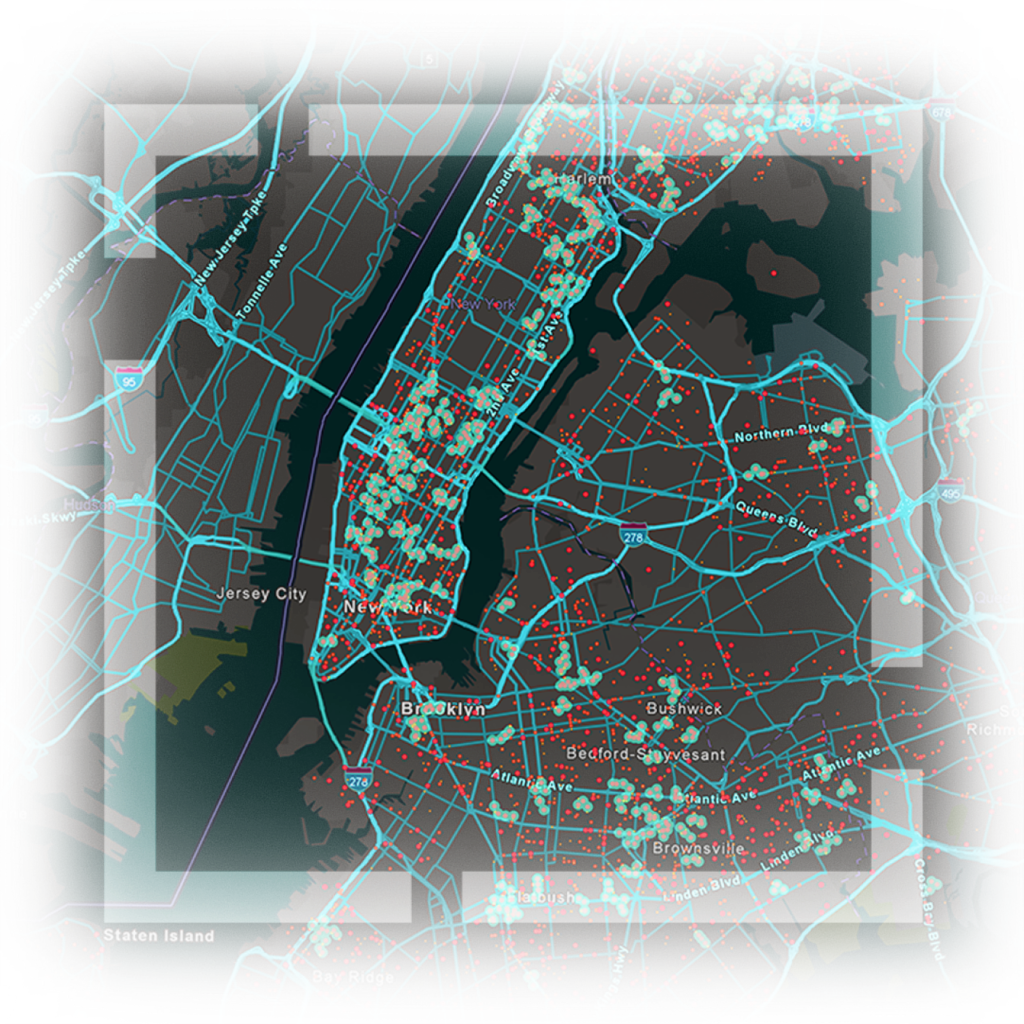Imagine being able to seize market opportunities, mitigate risks, optimize resources, and plan for the future with the power of spatial analytics. With the world’s leading spatial analytics software, you can analyze data in context, revealing hidden patterns and relationships that can help you understand the impact of your environment on the challenges you’re facing. By examining data in relation to its geographic location, you can uncover spatial patterns, trends, and connections that explain the “why” behind pressing environmental and business questions. With an unparalleled collection of spatial algorithms and methods, along with enterprise-grade analytics and seamless data integration, you can optimize operations using real-time understanding. Discover what’s possible with spatial analytics and harness the power of location intelligence for your organization.

This image is property of www.esri.com.
Benefits of Spatial Analytics
Analyze data in context
Spatial analytics allows you to analyze data in the context of its geographic location, revealing hidden patterns and relationships. By understanding how the environment around you affects the challenges you’re facing, whether it’s climate change, customer behavior, or resource allocation, you can make more informed decisions. Examining data in relation to its location can uncover spatial patterns, trends, and connections that explain the “why” behind pressing environmental and business questions.
Unparalleled collection of spatial algorithms
Esri, the world’s leading spatial analytics software provider, offers a comprehensive set of spatial algorithms and methods. These range from basic to advanced, ensuring that you have the tools you need to effectively analyze and interpret your data. With these algorithms at your disposal, you can gain valuable insights and make data-driven decisions with confidence.
Enterprise-grade analytics
Business and government leaders worldwide rely on Esri’s spatial analytics software to maintain operations and make informed decisions. Esri provides technical support when it’s needed most, ensuring that you have the resources and expertise to leverage spatial analytics effectively. With enterprise-grade analytics, you can optimize your operations, improve efficiency, and drive positive outcomes for your organization.
Align with data governance strategies
Esri’s software seamlessly stores, manages, and integrates geospatial data from multiple sources, ensuring a smooth data exchange and software interoperability. This alignment with data governance strategies allows you to maintain data quality, consistency, and security. By effectively managing and integrating your geospatial data, you can unlock its full potential and derive meaningful insights.
Optimize operations using location
Spatial analytics enables you to better manage your operations by leveraging real-time understanding. By combining historical and real-time data, you can optimize processes, such as bus routes in a city. For example, with ArcGIS, you can analyze data to optimize bus routes in New York City, resulting in improved efficiency and better service for commuters. By using spatial analytics to optimize your operations, you can drive positive outcomes and deliver value to your organization.

This image is property of www.esri.com.
Applications of Spatial Analytics
Manage the impacts of climate change
Spatial analytics plays a crucial role in managing the impacts of climate change. By integrating diverse geospatial data sources, such as maritime data and vessel tracking, organizations can understand the context and extent of climate change impacts. For example, Singapore’s maritime spatial atlas provides planners and scientists with valuable insights to optimize routes, identify risks, enhance efficiency, and promote sustainable maritime operations management. Spatial analytics allows organizations to make data-driven decisions to mitigate the impacts of climate change effectively.
Revamp wildfire resilience
Spatial analytics is used to revamp wildfire resilience by analyzing satellite imagery, radar data, and field-collected data. This comprehensive analysis helps organizations, like Portugal’s National Authority for Emergency and Civil Protection (ANEPC), to identify high-risk areas, predict fire behavior, and optimize resource allocation. By leveraging spatial analytics, organizations can improve response times, increase safety, and minimize environmental impact in wildfire-prone regions.
Ensure equitable traffic safety
Spatial analytics enables cities like Louisville to prioritize roadway safety by identifying high-risk corridors and implementing impactful improvement projects. By analyzing and understanding traffic patterns, accident data, and other relevant geospatial information, planners can make data-driven decisions to improve traffic safety. This approach not only increases transparency for city leaders and the public but also guides decision-making processes to ensure equitable traffic safety.
Delivering transformational results
Spatial analytics has the power to deliver transformational results across industries. By harnessing the insights derived from spatial analytics, organizations can drive environmental change, societal well-being, and economic growth. Industry leaders have implemented spatial analytics to optimize resources, mitigate risks, and seize market opportunities. Testimonials from these leaders showcase the potential and impact of spatial analytics in achieving transformational results.

This image is property of www.esri.com.
ArcGIS: The Comprehensive System
Data types and integration capabilities
ArcGIS, Esri’s geospatial software, includes and integrates with a diverse set of geospatial data types, such as raster, vector, point cloud, IoT sensor, 3D, and multidimensional data. This comprehensive system allows users to analyze data within ArcGIS or at the source of where the data lives. By embracing different data types and ensuring interoperability, ArcGIS empowers users to leverage all relevant data to drive action and make informed decisions.
Progressive analysis capabilities
ArcGIS offers progressive analysis capabilities, starting with foundational spatial techniques like geocoding, geoenrichment, and spatial overlays. As your needs evolve, ArcGIS provides advanced techniques such as modeling, geospatial artificial intelligence (GeoAI), and spatiotemporal statistics. With these analysis capabilities, ArcGIS allows users to explore and gain insights from their data using a wide range of techniques, ensuring that they can extract meaningful information and solve complex problems.
Interoperability with other tools and languages
ArcGIS is open and interoperable, allowing users to integrate and work with the tools and languages they already know. Whether it’s Jupyter notebooks, Python, R, or other widely used tools, ArcGIS enables seamless integration and collaboration. This interoperability ensures that users can leverage their existing skills and workflows while harnessing the power of spatial analytics.
Automation for scalability
ArcGIS enables users to run operations at scale by automating data generation, communication between applications, and routine analyses or tasks. By automating processes, organizations can save time, reduce manual effort, and increase efficiency. ArcGIS provides automation capabilities that allow users to focus on higher-level analysis and decision-making, making it a scalable solution for organizations of all sizes.
Sharing analysis results
ArcGIS allows users to share analysis results with anyone, anywhere, at any time. Users can collaborate with colleagues on analyses, share workflows, tell compelling stories, and enable others to analyze data using simplified apps created within ArcGIS. This sharing capability ensures that insights and findings can be easily disseminated, empowering others to make data-driven decisions and driving data-driven outcomes across organizations.

This image is property of www.esri.com.
Getting Started with ArcGIS
Explore real-world stories
In the Esri Blog, you can explore a collection of real-world stories from various industries that showcase the power and impact of spatial analytics. These stories highlight how organizations have leveraged ArcGIS to drive positive change, improve efficiency, and make informed decisions. By exploring these stories, you can gain insights into the possibilities of spatial analytics in your own industry.
Schedule a conversation with a sales consultant
To start your journey with ArcGIS, you can schedule a conversation with one of Esri’s experienced sales consultants. By discussing your organization’s workflows and challenges, the sales consultants can provide tailored guidance and demonstrate how spatial analytics can support your organization. This personalized approach ensures that you receive the necessary support to implement ArcGIS effectively and make the most out of spatial analytics.

This image is property of www.esri.com.
